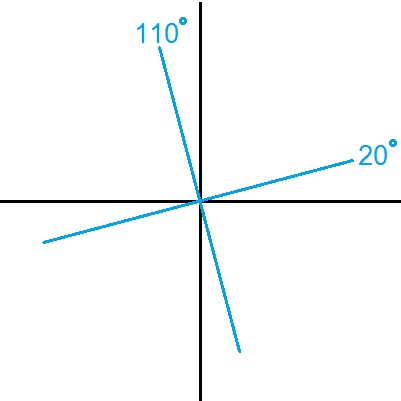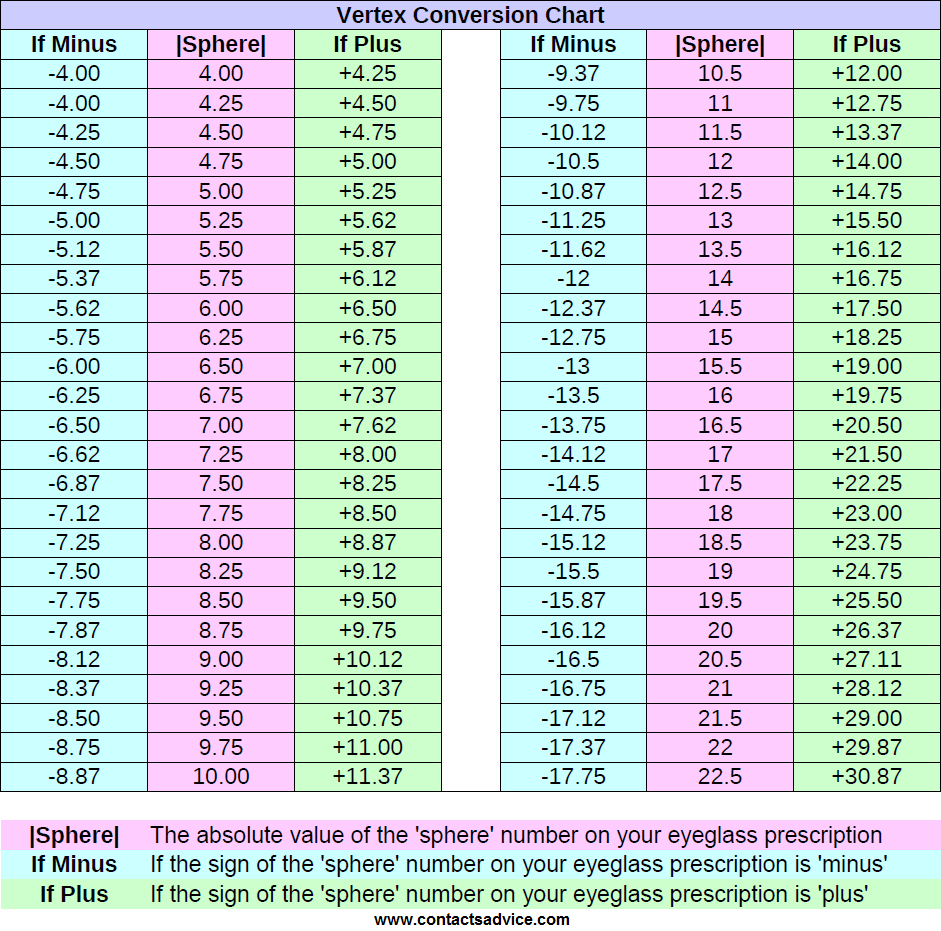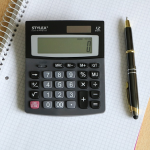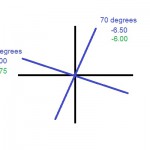The Axis
What is the Axis?
As I’ve discussed in part 1 and part 2 of this tutorial series, when you have astigmatism, it means that your cornea has 2 principle curvatures in it, which requires two different lens powers in order to make the vision clear.
What I haven’t discussed until now is that those two powers can be oriented in many different ways. The orientation that they take on will affect how the lens powers will have to be placed inside a pair of glasses (or contact lenses) in order for you to see clearly. This orientation of the lens powers is called the ‘Axis’.
Regular Astigmatism
In regular astigmatism (which is what the vast majority of people with astigmatism have), the two principle curvatures are orientated 90 degrees relative to each other.

For example:
If the first curvature has an angle of 0 degrees, the second curvature will have an angle of 90 degrees.
If the first curvature has an angle of 10 degrees, the second curvature will have an angle of 100 degrees.
If the first curvature has an angle of 20 degrees, the second curvature will have an angle of 110 degrees.
If the first curvature has an angle of 30 degrees, the second curvature will have an angle of 120 degrees.
And so on…
How is the Axis Measured?
The axis is measured at the same time as your ‘Sphere’ and ‘Cylinder’ powers. Your eye doctor will have you look at some letters on an eye chart through some lenses, and then he/she will rotate the lenses until your vision becomes the clearest. The orientation of the lenses when the vision is the best becomes your ‘Axis’.
How is the Axis Recorded?
Once the axis has been determined by your eye doctor, he/she will write down a number between 1 and 180 on your prescription in the ‘Axis’ column. Your glasses are then made according to that specification.
Is the Axis the Same in Glasses and Contact Lenses?
Yes and no. Ideally yes, they would exactly the same. However, in many cases an adjustment is necessary. Note that this is not a conversion like the ‘Sphere’ and ‘Cylinder’ powers. The adjustment is due to the fact that glasses can be made with any axis between 1 and 180 in 1-degree intervals, whereas most contact lenses can only be made in 10-degree axis intervals.
The end result is that the axis needs to be rounded up or down to the nearest 10 degrees.
For example:
If the axis on your glasses prescription is 12 degrees, the axis on your contact lenses would be 10 degrees.
If the axis on your glasses prescription is 38 degrees, the axis on your contact lenses would be 40 degrees.
If the axis on your glasses prescription is 170 degrees, the axis on your contact lenses would be 170 degrees.
If the axis on your glasses prescription is 65 degrees, the axis on your contact lenses could be either 60 or 70 degrees.
When Does the Axis Need to be Adjusted Further?
When you are first fitted with contact lenses, your eye doctor will select the axis in contacts that’s the closest to the axis for your glasses (using the rounding process described above).
However, you may end up with a different axis on your final contact lens prescription if the contact lenses don’t fit as predicted. There is an inherent amount of unpredictability in how contact lenses will center themselves on your eyes.
If you try on contact lenses with the exact same axis as your glasses, but the contact lenses are shifted 10 degrees off of center, then you would require an axis that is 10 degrees off of your glasses prescription. The only way to determine this is by examining the contact lenses on your eyes with a microscope.

Special Cases Are Treated Differently
If you have read this tutorial series from the beginning, you now have a pretty good understanding of how prescriptions are converted from glasses to contact lenses. However, there are prescriptions that don’t follow that I’ve described previously. I will cover these special cases here.
1. Glasses powers under +/- 4.00
After you’ve determined the two principle powers in your prescription, if the numbers are between 0 and -4.00 or between 0 and +4.00, converting the numbers is not necessary. The reason for this is that the difference between the original and converted numbers would be so small, that it cannot be practically applied to your prescription.
You may have noticed that numbers in prescriptions for glasses and contact lenses are always a multiple of 0.25. You can have a round number, such as -1.00, -2.00, -3.00, etc. And 3 different steps in between each, i.e., 1.00, -1.25, -1.50, -1.75, -2.00, -2.25, -2.50, -2.75, -3.00.
Smaller denominations are not possible. If you try to convert any number that’s less than +/- 4.00, the difference would be so small that it would not reach the next step up (or down), so the prescription remains the same.
2. ‘Cylinder’ Values of -0.25 on the glasses prescription
Cylinder powers of -0.25 are very common in glasses but do not exist in contact lenses. The effect of moving lenses from the distance at which they sit from your eyes in glasses to being directly on your eyes in contact lenses makes the -0.25 cylinder completely negligible in contact lenses.
Consequently, when converting a prescription from glasses to contact lenses, if the prescription for glasses contains a -0.25 ‘Cylinder’, it is completely ignored. It is treated as though there is no ‘Cylinder’ at all.
3. ‘Cylinder’ Values of -0.50 on the glasses prescription
Having a -0.50 ‘Cylinder’ on a glasses prescription represents a very small amount of astigmatism, but it’s not negligible like the -0.25 ‘Cylinder’ is. Just as contact lenses don’t come in ‘Cylinders’ of -0.25, they also don’t come in ‘Cylinders’ of -0.50. So how do you account for the -0.50 ‘Cylinder’?
You have to adjust the ‘Sphere’ number. -0.50 ‘Cylinder’ is equivalent to -0.25 ‘Sphere’. So essentially what happens is, the -0.50 ‘Cylinder’ in the glasses prescription is removed from the contact lens prescription, and to compensate for that, -0.25 is added to the ‘Sphere’ number.
Note that a negative number is ‘added’ to the ‘Sphere’, which means that resulting ‘Sphere’ should be more negative than the original (by 0.25).
Note also that it is important to perform this step before you convert the ‘Sphere’ number using your Vertex Conversion Chart. So in order, the process goes like this:
-
Disregard the -0.50 Cylinder. Your contact lens numbers will not have any ‘Cylinder’
-
Add -0.25 to the glasses ‘Sphere’ number.
-
Convert the glasses ‘Sphere’ number using a Vertex Conversion Chart.

With all of the information provided in parts 1-3 of this tutorial series, you have everything you need to be able to convert a prescription from glasses to contact lenses.
Remember that everything that is written on this website is for educational purposes only, and is not a substitute for going to your eye doctor’s to be professionally fitted with contact lenses. I do not condone or encourage anyone to convert their own prescription from glasses to contact lenses in order to order contacts online without seeing their eye doctor.
In part 4, the final part of this tutorial, I will discuss the power cross technique, which is a more visual way of working through a conversion, as well as different types of Vertex Conversion Charts that can convert both the ‘Sphere’ and ‘Cylinder’ number at the same time.




9 Responses
chanchila
so helpful !!!
Daniela Rivera
Is there any way you could help me figure mine out? I’m trying to figure it out but it’s difficult because my sphere numbers are lower than -1.0 AND one of my cylinders says SPH.
OD:
SPHERE: -0.50 CYLINDER: -0.75 AXIS: 172 ADD: +1.00
OS:
SPHERE: -0.75 CYLINDER: SPH. ADD: +1.00
Please reply as soon as you can,
Thanks!
Julie
Hi Daniela, good question!
When your cylinder section shows the letters “SPH” it means that you don’t have any cylinder. Eye doctors sometimes write “SPH” instead of “0” or “none”.
As for your sphere numbers, they are too low to need to be converted. That’s why you can’t find any charts with your sphere values. Only prescriptions with sphere numbers higher than -4.00 need to be converted.
So you really don’t have to do anything :)
Remember that the add number in your prescription means that with your contact lenses, you will not see perfectly clear up close unless you wear +1.00 readers over top.
Please note that this is just for educational purposes. I am not a doctor and I am not prescribing you contact lenses or anything else.
Taylor
My sphere is PL I. Where it should have numbers what does that mean?
Julie
Hi Taylor, PL is an abbreviation for the word ‘plano’ which is what eye doctors write instead of ‘0’ or ‘zero’. It means that you don’t have any sphere power for that eye. Hope that helps :)
Walter
Excellent series of articles! As an engineer, I was already familiar with the principles of optics. (In fact, I first realized I had astigmatism and sought out an eye doctor after learning how to recognize and eliminate various types of image distortions on an electron microscope.) But I was far less familiar with the nuances of how they are expressed in prescriptions, especially how values for eyeglasses correlate with those for contacts. You’ve explained it very well!
I should add that I particularly appreciate the inclusion of the back vertex formula. Tables are great for quick look-ups, but it’s nice to see and understand the “plumbing” that make them work. Plugging in the values for my own prescription, which is quite light, showed me exactly why the table gives the same values for both: the differences really are quite negligible. Doing this also increased my confidence in my current set of prescriptions. :)
Julie
Hi Walter, thank you so much for the kind words of encouragement. I’m elated that you found my articles helpful :)
Chris
Hi.
Re. Cylinder size of -0.5, If you then add -0.25 to sphere leaving you with 0 cylinder, how can you order lenses for astigmatism where the minimum cylinder option is -0.75? You could order non-toric lenses but then there’s no option for axis… What to do? Not sure is you can do the reverse and reduce the sphere while increasing the cylinder – but that might give you sphere sizes you can’t order anyway.
Julie
Hi Chris, good question.
When the cylinder in the glasses prescription is -0.50, you add -0.25 to the sphere and then you drop the cylinder and the axis. That means there is no need to order contact lenses for astigmatism. At that point regular ‘spherical’ contact lenses are all that’s needed. Generally speaking, optometrists and opticians never add to the sphere in order to increase the cylinder.
Hope this helps!